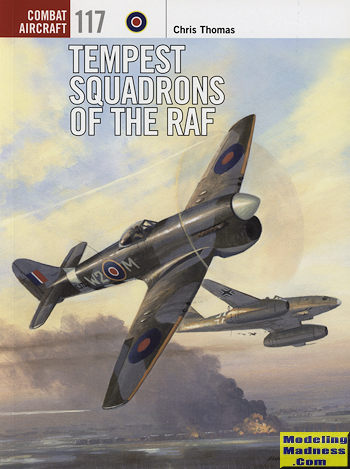 Hawker
aviation in the UK was probably one of the most innovative of all the British
aircraft manufacturers. From its speedy Hind bombers of the thirties to the
Harrier of the 1960s, Hawker continued to produce front line military aircraft.
This book is on the Tempest. This was a development of the Typhoon, a fighter
designed for air to air combat, but one that was much more suited to ground
attack, despite having a liquid-cooled engine.
Hawker
aviation in the UK was probably one of the most innovative of all the British
aircraft manufacturers. From its speedy Hind bombers of the thirties to the
Harrier of the 1960s, Hawker continued to produce front line military aircraft.
This book is on the Tempest. This was a development of the Typhoon, a fighter
designed for air to air combat, but one that was much more suited to ground
attack, despite having a liquid-cooled engine.
The Tempest started with the basic Typhoon airframe, changing the wing
to a laminar flow type. This not only provided greater speed but, along with an
increase in the size of the tail plane, made for a more maneuverable aircraft
that was a more stable gun platform.
Initially, the Tempest went through a number of different versions, each
powered by a different engine. The best of which was the Tempest II with the
Centaurus radial, an aircraft that many consider the best British piston-engine
fighter. However, engine issues continually delayed the introduction of this
plane and so it was the Tempest V, powered by pretty much the same engine as the
Typhoon which saw service during WWII.
The Tempest V first started entering squadron service just before D-Day.
It was planned to have Typhoon squadrons convert to the new type, but the need
for the Typhoon for the ground attack role, the rather slow production of the
Tempest V and the new threat from the V-1 kept the Tempest in the UK, where its
speed was a major plus when it came to dealing with the 'Doodlebug'.
Shooting down V-1s was not the piece of cake that people might think.
For one, the pilot had to get fairly close, which increased the issue of having
debris from the exploding bomb damage the aircraft. When the V-1 assault
switched to the night, there were issues regarding getting close enough as the
Tempest did not have a range finding gun sight. Eventually the progress of the
ground war took care of the threat to England and Tempest units moved to the
Continent to continue their service with the 2nd TAF.
Post war all the Tempest units were kept in Europe as part of the
occupation forces. Around this time, the Tempest II was finally coming off the
lines and while some units in Europe converted, others were sent to the Far East
to fight the Japanese. The war ended before than so they were kept in India,
many eventually being turned over to both the Indian and Pakistani Air Force.
Tempest VIs with more powerful engines were mostly stationed in the Near East
with units in Palestine and Egypt. The type was also used against Malayan
insurgents until replaced by other types.
There is, of course, a lot more to the story, including some superb
period photos, great selection of color profiles and the usual pilot stories, but I'll leave it to you to read the
book to discover that. The end result is a superb book on a type that often gets
overlooked by aviation enthusiasts. Highly recommended.
December 2016
Copyright ModelingMadness.com. All rights reserved.
For more on the complete line of Osprey books,
visit www.ospreypublishing.com
If you would like your product reviewed fairly and
fairly quickly, please
contact the editor or see other details in the
Note to
Contributors.
 Hawker
aviation in the UK was probably one of the most innovative of all the British
aircraft manufacturers. From its speedy Hind bombers of the thirties to the
Harrier of the 1960s, Hawker continued to produce front line military aircraft.
This book is on the Tempest. This was a development of the Typhoon, a fighter
designed for air to air combat, but one that was much more suited to ground
attack, despite having a liquid-cooled engine.
Hawker
aviation in the UK was probably one of the most innovative of all the British
aircraft manufacturers. From its speedy Hind bombers of the thirties to the
Harrier of the 1960s, Hawker continued to produce front line military aircraft.
This book is on the Tempest. This was a development of the Typhoon, a fighter
designed for air to air combat, but one that was much more suited to ground
attack, despite having a liquid-cooled engine.